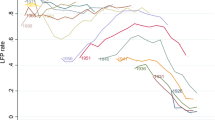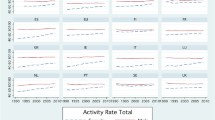Abstract
We use a cohort-based model to analyse the determinants of labour force participation in six European economies, focusing on age and cohort effects as factors explaining differences in participation behaviour across countries. Cohort effects are particularly relevant for women with those born in the late 1960s and early 1970s more likely to participate over the life-cycle. Our results suggest that cohort effects can be interpreted as evolving social norms or preferences towards participating in the labour market according to Fernandez (NBER working paper no. 13373, 2007). We find substantial variation in the estimated age and cohort effects across European countries: cohort effects can account for a substantial part of the recent increase in participation in Spain, the Netherlands and Germany, and a positive, but smaller part of in the increase in participation of the UK, Italy and France. Looking forward, positive cohort effects could help counteract the downward impact of population ageing on participation.






Similar content being viewed by others
Notes
Another related strand of the literature has documented the impact of labour market institutions on employment and unemployment in European countries (for a recent contribution and review of the literature, see Bassanini and Duval 2006 and Bertola et al. 2007 for an age-group-specific analysis). Participation decisions have received less attention in this context. However, Blöndal and Scarpetta (1999) and Duval (2006) focus on older workers and their retirement decisions and Jaumotte (2003) on females. Genre et al. (2005, 2010) use annual data for a panel of European Union countries to estimate participation equations for age and gender groups to identify the impact of labour market institutions in participation decisions. They find that higher union density, more employment protection and more generous unemployment benefits lower participation rates. We argue that changes in institutions alone cannot explain the trends in participation rates observed in the data. We therefore add to the studies mentioned above by considering disaggregated groups and by incorporating the impact of a broader set of factors through the age and cohort effects together with observed determinants of participation in the same model.
See Fig. A1 in the Electronic Supplementary Material.
Participation behaviour also varies across other personal characteristics, such as education and skills, immigrant status, wages, etc. We focus on age and gender for reasons of data availability: in particular, LFS data by education categories are only available from the early 1990s onwards. These data show that more educated workers tend to have higher participation rates and that an increase in overall educational attainment over time has coincided with an increase in participation rates, particularly for women. We will partly control for that using youth in education to test the robustness of our results. The LFS does not include information on wages.
A detailed description of the sampling methods and adjustment procedures used in the LFS can be found in “The European Union Labour Force Survey—Methods and Definitions, 2001”, the available variables are listed and described in the “EU Labour Force Survey database—User guide”. The change from annual to quarterly periods by Eurostat has resulted in breaks in the LFS in many euro area countries. Therefore, we rely on the more consistent spring (second quarter) data throughout the sample period, except for France (where data refer to the first quarter). Data for Spain and the UK are only available for those above 16.
The idea is to generate a series that is representative for overall Germany also before 1991. While this allows us to solve the issue of the break in the series in 1991, it assumes that Eastern and Western participation rates have developed in a comparable way before 1991 and/or that developments in Eastern participation rates have been dominated by Western participation rates as the West accounts for 80 % of the population.
The most important difference between our approach and Fallick and Pingle is this logistic transformation of the participation rate for males and females. Further, Fallick and Pingle merge single ages into groups of 2–5 years. Due to the hump-shaped age-participation profile, participation changes strongly between the very young and very old ages. As some cohorts only enter a few age groups at the end of the range, this leads to jumps in the estimated cohort effects for those cohorts that enter more age groups than the predecessor. We avoid this “cycling” of cohort effects using single ages instead of age groups.
We do this by replacing the values of the participation rate and the other explanatory variables of the ages affected with means from the rest of the sample. We also restrict the cohort effects of the last eight cohorts to equal the average of the remaining cohorts for the respective age.
There is a large literature on identifying causal effects of institutions using reforms in various countries or additional information related to the causality of the effects. For example Lechner and Wiehler (2011) evaluate the impact of labour market programs on female participation in Austria by investigating the reduction and postponing of pregnancies.
The full estimation results including \(t\) tests are provided in the Electronic Supplementary Material.
Full estimation results, including goodness of fit measures are available upon request.
While union density, unemployment benefits and labour taxes are included in the equations for all age and gender groups (in working age), the implicit tax on continued work is only included for the oldest workers and the female part-time employment rate for females only.
See http://www.barrolee.com/ for their data. Figure A5 in the Electronic Supplementary Material plots educational attainment for our set of countries.
Prieto-Rodriguez and Rodriguez-Gutierrez (2000) find these effects to be relevant for women in Spain, in line with our finding of negative business cycle effects for women of all ages.
Results are documented in Fig. A4 in the Electronic Supplementary Material. In order to construct a scenario for future labour supply, we use population projections from the New Cronos database by Eurostat (EUROPOP2008). EUROPOP2008 contains statistical information on population projections with reference to projected 1st of January population by sex and single year of age, projected vital events (births and deaths) and assumptions concerning fertility, life expectancy at birth by sex and international migration. We keep observed determinants at their 2007 values and we fix the cohort effects for the young cohorts, i.e. the last eight cohorts of our sample and those that enter the labour market after 2007, at the level of the last cohort effect we estimate, namely those born in 1984.
Results are available upon request.
References
Aaronson S, Fallick B, Figura A, Pingle J, Wascher W (2006) The recent decline in the labour force participation rate and its implications for potential labour supply. Brookings Papers on Economic Activity, March
Antecol H (2000) An examination of cross-country differences in the gender gap in labor force participation rates. Labour Econ 7(4):409–426
Bassanini A, Duval R (2006) Employment patterns in OECD countries: reassessing the role of policies and institutions. OECD Economic Department working papers, No. 486. OECD, Paris
Beaudry P, Lemieux T (1999) Evolution of the female labour force participation rate in Canada, 1976–1994: a cohort analysis. Can Bus Econ 7(2):1–14
Bertola G, Blau F, Kahn L (2007) Labor market institutions and demographic employment patterns. J Popul Econ 20:833–867
Blanchard O, Wolfers J (2000) The role of shocks and institutions in the rise of European unemployment: the aggregate evidence. Econ J 110(462), 1–33. Econ J 110(462):1–33
Blöndal, S, Scarpetta S (1999) The retirement decision in OECD countries. OECD working papers, No. 202. OECD, Paris
Burniaux J, Duval R, Jaumotte F (2004) Coping with ageing: a dynamic approach to quantify the impact of alternative policy options on future labour supply in OECD countries. OECD Economics Department working papers, No. 371. OECD, Paris
Carone G (2005) Long-term labour force projections for the 25 EU member states: a set of data for assessing the economic impact of ageing. DG ECFIN Economic paper, No. 235. DG ECFIN, Brussels
Duval R (2006) Pension systems, social transfer programmes and the retirement decision in OECD countries. In: Messina J, Michelacci C, Turunen J, Zoega G (eds) Labour market adjustments in Europe. Edward Elgar, Cheltenham
Euwals R, Knoef M, van Vuuren D (2011) The trend in female labour force participation: what can be expected for the future? Empir Econ 40:729–753
Fallick B, Pingle J (2007) A cohort based model for labour force participation. Finance and economics discussion series. Board of Governors of the Federal Reserve System, Washington, DC
Fernandez R (2007) Culture as learning: the evolution of female labor force participation over a century. NBER working paper, No. 13373. NBER, Cambridge
Fernandez R, Fogli A (2009) Culture: an empirical investigation of beliefs, work, and fertility. Am Econ J Macroecon 1(1):146–177
Fitzenberger B, Wunderlich G (2004) The changing life cycle pattern in female employment: a comparison of Germany and the UK. Scott J Political Econ 51(3):302–328
Fitzenberger B, Schnabel R, Wunderlich G (2004) The gender gap in labor market participation and employment: a cohort analysis for West Germany. J Popul Econ 17:83–116
Genre V, Gomez-Salvador R, Lamo A (2005) The determinants of labour force participation in the EU. In: Gómez-Salvador R, Lamo A, Petrongolo B, Ward M, Wasmer E (eds) Labour supply and incentives to work in Europe. Edward Elgar, Cheltenham
Genre V, Gomez-Salvador R, Lamo A (2010) European women: why do(n’t) they work. Appl Econ 42(12):1499–1514
Goldin C (2006) The quiet revolution that transformed women’s employment, education, and family. Am Econ Assoc Pap Proc 96(2):1–21
Greene William H, Seaks Terry G (1991) The restricted least squares estimator: a pedagogical note. Rev Econ Stat 73(3):563–567
Jaumotte F (2003) Female labour force participation: past trends and main determinants in OECD countries. OECD Economics Department working papers, No. 376. OECD, Paris
Lechner M, Wiehler S (2011) Kids or courses? Gender differences in the effects of active labor market policies. J Popul Econ 24:783–812
Mason W, Fienberg S (1985) Cohort analysis in social research: beyond the identification problem. Springer, New York
Prieto-Rodriguez J, Rodriguez-Gutierrez C (2000) The added worker effect in the Spanish case. Appl Econ 32:1917–1925
Uhlig H, Ravn M (2002) On adjusting the HP-filter for the frequency of observations. Rev Econ Stat 84(2):371–376
Acknowledgments
We would like to thank numerous participants and colleagues for helpful comments. The views expressed in this paper are those of the authors and do not necessarily reflect those of the International Monetary Fund.
Author information
Authors and Affiliations
Corresponding author
Electronic supplementary material
Below is the link to the electronic supplementary material.
Rights and permissions
About this article
Cite this article
Balleer, A., Gomez-Salvador, R. & Turunen, J. Labour force participation across Europe: a cohort-based analysis. Empir Econ 46, 1385–1415 (2014). https://doi.org/10.1007/s00181-013-0716-3
Received:
Accepted:
Published:
Issue Date:
DOI: https://doi.org/10.1007/s00181-013-0716-3




